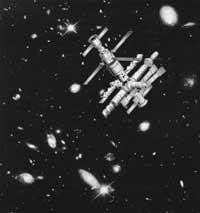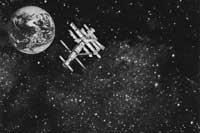Mir: a bad day in space

When the Progress transport collided with the Spekrt module it seemed that the MIR space station did, and the three astronauts who were there were about to abandon it, but finally, thanks to the collaboration of the space agencies of the USA and Russia, the duration of the station has been somewhat assured. Michael Foal has brought to Earth information about these serious events, providing the version of those who lived in it.
The first module of the MIR space station was launched into space on February 20, 1986 by the Russian Space Agency to meet and replace the dead Salyut 7 station. Since then, it has been circling around the Earth, about 300 kilometers, and for eleven years it has always been inhabited by Soviet or Russian astronauts, but also Germans, Japanese, Austrians and Americans.
In the then Soviet Union the mission was officially described as “orbital scientific research station for the development of science and national economy”. The MIR module was the first complement of the space station of the same name, later used as an astronaut residence. One by one, more specialized modules in space laboratories were added, forming a gigantic mecano: Kvant, Kvant2, Kristall, Spektr and Priroda. Among others, the orbital station has been studying the nature of materials and conducting biotechnological research over the past eleven years.
Throughout these years there have been technical problems in the MIR space station, but there have never been crises the size of the accident occurred in June and the subsequent power outage. On the afternoon of 25 June astronaut Vasili Tsibliev was commissioned to manually dock the Progress supply vessel, as it was too expensive for Russia to acquire automatic driving tools from Ukraine. Therefore, a camera mounted on the Progress ship was used to guide the ship to the station transfer module.
To do this, they only had a black and white screen, sketched and confused. They had previously made a simulation with the same device, but at the last moment the screen signal had disappeared due to the bad connection. Finally, what had to happen happened: the docking test went wrong and the Progress ship hit the MIR station at high speed. Tsibliev had great problems with the Russian Space Agency, which was in charge of leading the Progress and which remains guilty of the mission's failure alongside Lazutkin.
At the time of the collision he ran by order of Tsibliev towards the escape ship Foale Soiuz, as the astronauts saw the Progress ship approaching at high speed from a box office. They expected the worst, so Tsibliev commissioned Foale to prepare the Soyuz escape ship for the getaway. It was the first time the last minute flight was made at MIR station. When cutting the cables that connected the ship with other modules, he saw Lazutkin do the same with the Spektr module. “I’ve seen it.” “It’s been Spektr.” They could not know to what extent the module was damaged, but just in case it was decided to isolate it from other modules, since a leak would cause the depressurization of the entire station. This caused the loss of electricity generated by Spektr solar panels.
After the initial emergency, Commander Tsibliev spoke with the Russian Agency asking permission to finish the mission and return to Earth. He repeatedly refused ground control: they had to keep him in position and try to recover the MIR station. The state of the station, however, was nothing relaxing: The collision received by the Spektr module broke the solar panels of the module and turned the entire station changing the orientation of the other solar panels with respect to the sun. Therefore, the MIR station was without power. Thus, there was no possibility of igniting the propellers, so it was impossible to return the station to its correct orientation.

The only way to place the orbital station in place was to stop its turn and then turn a few degrees using the propellers of the ship Soiuz to use the solar panels of Soiuz himself. Since they did not have electricity, they had to calculate their speed of rotation manually with the position of the stars and taking as reference the arm of Foale, which allowed to calculate from the ground control the speed of rotation of the station. Manual measurements were of the order of a degree, but finally managed to slow down the station. Once the station was paralyzed, it was easy to correct its orientation and after a long period of waiting, they began to illuminate individually the buttons of the controls, resurrecting the MIR space station of death. For Foale, the astronaut's ability and cold blood was the salvation of the MIR space station, in which astronaut Vasili Tsibliev, who was later condemned by the Russian Space Agency, was very heavy.
At present, the MIR station is in operation again and after recovering all its functions it is still able to continue researching scientists in space. However, Foal, Lazutkin and Tsiblev will never forget the time they spent on Earth in all the darkness, as they learned well the loneliness of being 300 kilometers from Earth and the impotence of living in an airtight box.
The blame for all this is not relevant in relation to the risk of such accidents. Eleven years later, the MIR space station is in its late days and has taught us that it is still necessary to develop a lot of technology. In this way, the new ALFA space station, which will be launched in four years, will aim to extend the time of human permanence in space, improve their standard of living and develop new technologies. It is clear that throughout your life you will find many difficulties, as anyone can have a bad day in space.
More serious technical problems of the MIR space station in 199723 February: An oxygen generator of the Kvant module burns filling the smoke station and cutting the escape to astronauts. Early March: The two main oxygen generators are damaged forcing them to use oxygen generators similar to those that originated the fire. Early April: Damaged cooling system, increasing temperatures and causing respiratory problems. Then the air wash system fails. 25 June: The transport ship Progress collides with the Spektr module leaving the station without power. 17 July: In a power recovery test, Lazutkin disconnects the straight cable, inusing the computer that controls the orientation of the station. 18 August: The main computer fails when the transport boat is embarking. 8 and 14 September: Again the central computer fails, generating the loss of orientation of the MIR station. |





